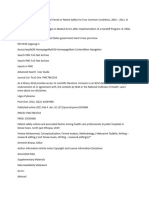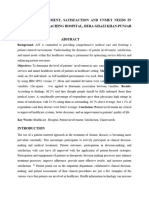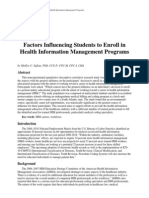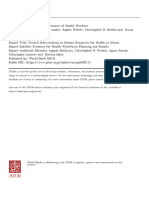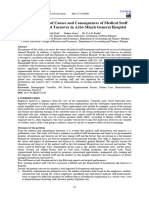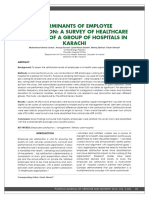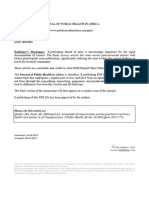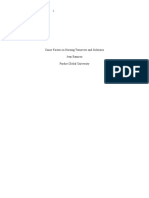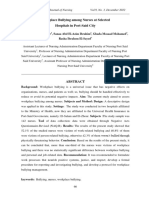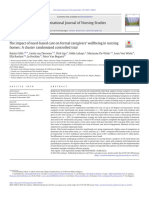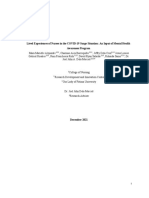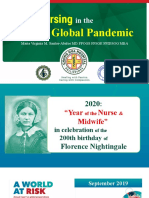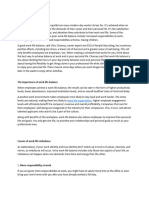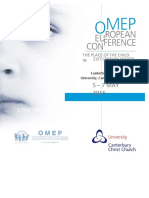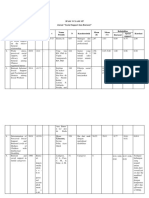Burnout Among Healthcare Professionals in Ghana A Critical Assessment
Burnout Among Healthcare Professionals in Ghana A Critical Assessment
Uploaded by
ETON VICTORIACopyright:
Available Formats
Burnout Among Healthcare Professionals in Ghana A Critical Assessment
Burnout Among Healthcare Professionals in Ghana A Critical Assessment
Uploaded by
ETON VICTORIAOriginal Title
Copyright
Available Formats
Share this document
Did you find this document useful?
Is this content inappropriate?
Copyright:
Available Formats
Burnout Among Healthcare Professionals in Ghana A Critical Assessment
Burnout Among Healthcare Professionals in Ghana A Critical Assessment
Uploaded by
ETON VICTORIACopyright:
Available Formats
Journal Menu PDF
Article Sections
Research Article | Open Access
Volume 2020 | Article ID 1614968 |
https://doi.org/10.1155/2020/1614968
Show citation
Burnout among Healthcare
Professionals in Ghana: A
Critical Assessment
Stephen T. Odonkor 1 and Kwasi Frimpong1
Show more
Academic Editor: Rui Liu
Published: 21 Mar 2020
Abstract
Health workers are prone to burnout, which can
have an adverse effect on their person and the
patients to whom care is offered. The goal of this
paper was to assess the levels of burnout
experienced by healthcare workers in Accra, Ghana.
The study was conducted using the cross-sectional
study design. Questionnaires were used to obtain
data from 365 respondents who worked in 12 major
healthcare facilities. Data obtained were analyzed
with SPSS version 23. Majority of the respondents
were females (56.7%) as against males (43.3%). The
total score for all burnout variables among health
worker groups ranged from good (71.50%),
alarming (12.60%), acute crisis (6.02%), and
burnout (9.90%). Among the health worker groups,
nurses had the highest percentage score values for
all burnout variables. There was an association
between burnout and these sociodemographic
characteristics: age ( ), gender (
), educational qualification ( ),
occupation ( ), years of work experience (
), marital status ( ), and
parenthood (having children) ( ). It is
recommended that measures should be put in place
in Ghanaian hospitals to assess stress and burnout
levels to ensure people who are going through such
situations are properly cared and supported.
1. Introduction
Burnout poses health risk among working
populations especially young people, yet it has
largely been neglected as a result of the increasing
work pace, coupled with the rapidly growing
demands on workers [1]. Burnout is defined as
“complete emotional, physical, and mental
exhaustion” [2]. A burnt-out person experiences
further frustration because of inability to perform
on the job. Burnout presents a challenge that
transcends all occupations and professions
especially for care- and service-based professions
such as health workers. Employees experiencing
elevated levels of burnout, although seldom
complain to colleagues or supervisors, tend to
demonstrate apathy to their job roles and schedules.
Absenteeism and employee turnover are key
manifestations of burnout. Furthermore, burnout is
also known to negatively affect productivity, lower
job satisfaction, and decrease organizational
citizenship behaviors.
It is estimated that healthcare workforce represents
12% of the working population worldwide [3].
Healthcare professionals work in groups
(multidisciplinary specialized team of experts) that
support and assist the health and well-being of
mankind. This places a high demand on their team
members; thus, they face the risk of burnout. This is
further compounded because healthcare
professionals work in an environment that is
cogitated to be one of the most hazardous
occupational settings [4, 5]. Indeed, it is worth
noting that the attention to burnout was first brought
to light as a result of the situation of nurses in
hospice care [2].
Transience of life, helplessness, sufferings, futile
battle, and grief are encountered by the healthcare
worker on a daily basis. Thus, it is of importance to
take care of their psychological well-being, which
may subsequently influence the well-being of the
patients who have been entrusted under their care
and supervision [6]. Furthermore, burnout and low
engagement in healthcare setting may negatively
affect patient care, undermine the workforce, and
rise turnover [7]. This presents with interruption in
continuity of care and associated high cost with
regard to hiring new healthcare professionals.
Invariably, it is believed that where there is a happy
caregiver, there is also a satisfied patient [8]; thus,
an output of high-quality care for clients and
patients alike must necessarily be preceded by high-
quality care for the health worker.
In sub-Saharan Africa, not much attention has been
given to burnout issues among health workers, as
most attention is directed mainly towards the
occupational health and safety of the health worker
due to diverse hazards related to their work-related
activities [7, 9–11]. However, a burnout worker is
much more prone to occupational hazards.
Secondly, in situations where burnout has been
investigated, it is usually limited to just a few
categories of health workers; thus, one cannot
determine the trends among the diverse category of
health workers. Additionally, the growing attention
to burnout and employee engagement in healthcare
must be matched by better evidence about how
burnout affects the workforce, patient care, and
healthcare organizations [7, 12, 13]. The goal of
this paper was to assess the levels of burnout
experienced by healthcare workers, aimed at
identifying the various sources of burnout and
coping mechanism developed by the healthcare
workers.
2. Methodology
2.1. Description of the Study Location
The study was conducted in the Greater Accra
Region of Ghana, which lies on the southeastern
part of the country. The region occupies a total land
area of 3,245 sq. km. It is the national capital of the
16 political regions in Ghana. It has a population
density of 1,235.8 people per sq. km. The region is
90.5% urban with an annual urban growth rate of
3.1%. It experiences more inflows of people from
other parts of the country than people moving out
from the region [14].
2.2. Study Design and Sample Size
The study employed the cross-sectional design to
obtain quantitative data via pretested
questionnaires. The study was carried out in twelve
(12) healthcare facilities in the national capital of
Greater Accra Region of Ghana. The study
population included health workers in the hospitals
who fell under the following categories: doctors,
nurses, pharmacists, medical laboratory scientists,
and radiographers.
The sample size was determined using Miller and
Brewer’s mathematical formula for estimating
single proportions [15]. The standard normal
deviation was set at a 95% confidence level,
prevalent with the allowable margin of error of
0.08. The formula was used to
determine a sample size for each hospital. The
minimum sample size increased and rounded up
when 10% of the calculated minimum sample size
was added for nonresponse and inappropriately
filled or missing questionnaires since the
questionnaires were interviewer administered. In the
formula, is the sample size, is the total
population, and is the margin of error, adopted
from Miller and Brewer [15]. Thus, a total of 385
questionnaires were distributed for the study.
However, 365 were completely filled and returned.
This represent a 95% response rate.
2.3. Sampling Technique
The study utilized a stratified sampling technique to
obtain the required number of respondents from
each of the five (5) category of healthcare workers.
Thus, in selecting the respondents, sampling
proportionate to size was used to determine the
number of healthcare workers to be interviewed
from each category of healthcare workers.
2.4. Data Collection and Analysis
This study took place between September 2018 and
December 2018. A standardized questionnaire
developed by Pines et al. was used [16, 17] to
obtain data. Field inspection of questionnaire data
was carried out days after the interview was
conducted, and any errors were immediately
verified and corrected. The survey instrument
comprised 21 questions to be answered on a seven-
point Likert scale. Burnout scores were calculated
as previously reported [16] and categorized into
four levels: very good to good (less than 3),
alarming (3 to 3.9), burnout (4 to 5), and acute
crisis (more than 5). Furthermore, the questionnaire
also captured demographic data of the respondents.
It took approximately 25–35 minutes to complete
the instrument. Six experts in social science
measurement and evaluation determined face
validity of the instrument. The average overall face
validity was equal to 95%. The study used
Cronbach’s alpha test formula to test the reliability
of the standard questionnaire (Pines et al. burnout
questionnaire). The test yielded a reliability
coefficient of 0.8. Cronbach’s alpha test assesses the
internal consistency of a set of scale or of items to
ensure that they are all consistent in measuring the
same attributes under study [14].
2.5. Ethical Considerations
The protocol for the study was ethical and was
cleared by the Ethics Review Committee of the
Ghana Institute of Management and Public
Administration. Prior to data collection,
respondents’ written and verbal consent was sought.
Respondents were informed about the purpose of
the study and were made to understand that
participation was voluntary and refusal to
participate in the study would not affect their
employment status. The study respondents were
assured of confidentiality and informed that they
could withdraw from the study at any time and were
at liberty not to answer any question they did not
want. All respondents were advised that completing
the survey implied informed consent to use the data
for research purposes. In addition, all personal
identifiers were removed in the summary data to
ensure confidentiality.
2.6. Data Handling and Analysis
The data were entered into a spreadsheet and later
exported to SPSS version 23 and coded for analysis.
The analysis included both descriptive and
inferential statistics.
Descriptive statistics (frequencies, means, and
standard deviations) were used to describe the
variables of interest. Univariate analysis was used in
obtaining the frequency of sociodemographic
characteristics and other discrete variables of the
study population. Data were analyzed by
contingency tables except for -tests as appropriate
for continuous data (for example, age). The chi-
squared ( ) tests were used to assess the bivariate
relationships between these factors as well as for
difference in proportions and for other categorical
variables. Other descriptive statistics such as the
absolute and relative frequency, arithmetic mean,
standard deviation (SD), and median (MED) were
also computed [18, 19].
All statistical tests were two-tailed, and
or less was considered statistically significant.
3. Results
3.1. Sociodemographic Characteristics
The sociodemographic characteristics of
respondents are presented in Table 1. The research
revealed that more than half of the respondents
(52.1%) were between the ages of 20 and 30 years.
While 207 (56.7%) of them were females, most of
them were Christians (93.7%) and were single
(55.34%). Most of the respondents were Akans
(56.7%), and most of them (41.4%) had bachelor’s
degree as their educational qualification. It was also
observed that most of the respondents were nurses
(65.2%), and 49.3% of them have 1-5 years of
working experience. Moreover, 54.0% of the
respondents work in district hospitals, with 58.3%
working in the outpatient department.
Table 1
Sociodemographic characteristics of respondents.
Table 2 represents the burnout scores among
various health worker groups: doctors, nurses,
pharmacists, laboratory scientists, and
radiographers. The total score for all burnout
variables among health worker groups ranged from
good (71.50%), alarming (12.60%), acute crisis
(6.02%), and burnout (9.90%). Among the health
worker groups (doctors, nurses, pharmacists,
laboratory scientists, and radiographers), nurses had
the highest percentage score values for all burnout
variables: good, alarming, acute crisis, and burnout
(48.77%, 6.85%, 2.74%, and 6.90%, respectively),
followed by doctors and the least representing
radiographers. Radiographers reported the same
least score value (0.27%) for alarming, acute crisis,
and burnout score. Acute crisis and burnout scores
were reported lowest for both pharmacists and
radiographers (0.27%, respectively). Laboratory
scientists indicated the same percentage score value
of 0.55% for alarming and acute crisis scores.
Table 2
Burnout score among the health worker groups.
Table 3 shows differences in the degree of burnout
and some selected sociodemographic
characteristics. Among the health worker groups,
female respondents reported the highest burnout
(63.89%) as against their male counterparts
(36.11%). Respondents who were married had
higher rates (58.33%), followed by those who were
single (27.78%) and the least representing
widow/widower (5.56%). Within the educational
background of the health worker groups,
respondents who had a bachelor’s degree exhibited
higher (30.56%) burnout, followed by those with
diploma qualification (25.00%). The respondents
with the least burnout score among the education
category were those with PhD qualification
(2.78%). Health workers stationed at the inpatient
departments showed higher burnout levels (63.89%)
as against those who worked at the outpatient
departments (36.11%). Health workers who have
children (parenthood) have higher burnout rate
(58.33%) as against those who did not have any
children (41.67%).
Table 3
Differences in the degree of burnout and selected
sociodemographic characteristics.
Table 4 presents the results of influence of
sociodemographic characteristics on burnout among
the health workers. The results show that there was
an association between burnout and
sociodemographic qualities: age ( ),
gender ( ), educational qualification (
), occupation ( ), years of work
experience (p < 0.001), marital status ( ),
and parenthood (having children) ( ).
Table 4
Chi-squared test of association between burnout and
related characteristics.
Table 5 presents the correlation matrix of the
relationship between selected demographic
characteristics and burnout. Among the positive
correlations, the following variables were
significantly different ( ) between each
other: age and marital status (0.054) and occupation
and children (0.039).
Table 5
Correlation between selected variables and burnout.
Table 6 shows the multiple logistic regression
model for the influence of sociodemographic
characteristics on burnout. The results show that
females were 1.2 times more likely than males to
experience burnout. Respondents between the ages
of 41 and 50 were more likely to experience
burnout when working than those in the other age
groups. There was however a more significant and
appreciable relationship between burnout and age:
41-50 years ( ). Regarding educational
qualification, the results indicate burnout increases
with level of education. Also, a significant
relationship was established between nurses and
burnout: . The results also show that
those who had worked at the hospital for 6-10 years
were 3.7 times more likely to experience burnout.
Table 6
Multiple logistic regression model for the influence
of sociodemographic characteristics on burnout.
Figure 1 shows the sources of perceived burnout
among the health workers. Result shows that most
of the health workers’ experience indicated that
burnout was from administrative work (32.88%),
followed by being confronted with suffering
(30.41%) and time pressure (24.66%) in that order.
The least pressure encountered was from
relationships with patients (0.82%) followed by
individual decision-making (2.47%). Burnout from
relationships with colleagues and relatives of
patients (4.66% and 4.11%, respectively) was barely
rare.
Figure 1
Sources of burnout.
The most common defense against burnout is
represented in Figure 2. Most of the health workers
reported that they are able to get support from
family (57.26%) to minimize burnout. This is
followed by those who use their interest/hobbies
(16.44%) to minimize the effect of burnout. The
least defense against burnout was professional help
(2.47%). Other defenses against burnout include
company (4.66%), friends (3.83%), relaxation
techniques (4.11%), solitude (6.85%), and sports
(6.85%).
Figure 2
Most common defense against burnout.
4. Discussions
The objective of this study was to determine the
levels of burnout experienced by healthcare
workers, aimed at identifying the various sources of
burnout and coping mechanism developed by the
healthcare workers. The assessment was done
among 4 different groups of health workers (nurses,
doctors, pharmacists, laboratory scientists, and
radiographers). Just as it is in most occupations,
health workers also go through some form of
tiredness or exhaustion. However, persistent
frustrations and thwarts on the work of people could
turn exhaustion to burnout [20]. The extent of
burnout among the various groups of health
professionals was found to be 9.90%. This confirms
reports indicating the presence of burnout among
various healthcare providers in low- and middle-
income countries [21]. On the other hand, results
from this current study disagree with a similar study
by Pavelková and Bužgová [22], Whitebird et al. [2
3], and Alkema et al. [24] where burnout scores
were low.
The challenges and nature of healthcare affect the
psyche of these healthcare workers. Thus, in
addition to addressing psychological factors,
management of hospitals should improve physical
working conditions of health workers and engage
them in various exercises occasionally to prevent
burnout situations [6, 21, 25].
There was an association between burnout and
sociodemographic qualities: gender, age,
educational qualification, occupation, years of
experience, marital status, and children. Several
similar studies have showed female health workers
having more vulnerability to emotional exhaustion
than males and as a result were more prone to
burnouts than their male counterparts [26, 27].
Similar explanations could be attributed to what
was reported in this study where females had 1.2
times more vulnerability to burnouts than males
(Table 6).
From the current study, it was revealed that among
the occupations in health institutions, nurses had the
highest vulnerability in experiencing burnouts.
Chou et al. [28] in their study on job burnout and
burnout in hospital employees identified nurses as
the most burnt-out among health workers in
hospitals at Taiwan. This is understandable because
nurses deal with deaths daily, go through emotional
challenges of losing patients regularly, are
constantly faced with consoling grieving relatives
of patients, and sometimes have to go on relatively
long shifts thereby causing emotional exhaustion or
burnouts [29–31]. Generally, it is widely known that
females dominate the nursing occupation [32]. The
higher number of females in the nursing fields as
compared with males coupled with a higher burnout
partly explains the strong correlation between
occupation and gender (Table 5).
It was also found from this current study (Table 6)
that older people between 41 and 50 years were
more vulnerable to burnouts than the other age
groups. This is in agreement with the work done by
Bijari and Abassi [33], where they found that that
older health workers aged 40-50 have a greater
subjection to psychological and physical
oppressions caused by fatigue resulting from
overworking and carrying out tedious duties.
Irrespective of the health worker group, it was
revealed from this study that the higher the working
experience, the more likely it is for any health
professional to encounter burnouts. Work
experience may not have a direct influence on
burnouts but could be a mediator of the other
sociodemographic factors. Furthermore, it was
revealed that health workers who are parents or
married tend to suffer burnouts more than those
who are single. Explanations for this observation
include the extra responsibilities, frustrations, and
sometimes emotional challenges encountered by
parents or married health workers.
The causes of burnout identified by the respondents
were administrative work, being confronted with
suffering, individual decision-making, relationship
with colleagues, relationship with patients,
relationship with relatives of patients, and time
pressure. However, the main causes were
administrative work (32.88%), being confronted
with suffering (30.41%), and time pressure (24.66).
Pavelková and Bužgová [22] in their study on
burnout among hospital workers in Czech Republic
also indicated administrative work, being
confronted with suffering, and time pressure as the
main causes of burnout. Also, their study and this
one identified relationship with patients as the least
distressing. Workers may consider administrative
work pointless and distressing if supervisors or
superiors show incompetency, do not give
feedbacks, and also make irrelevant changes in
hospital regulations [2, 22].
The current studies showed health workers
prevented burnout mainly by support from family
members and interests/hobbies which was
consistent with a similar study by Pavelková and
Bužgová [22] and Funk [8]. This observation stands
to reason because families are sources of all kinds
of support including moral, emotional, financial,
and physical support. Hobbies on the other hand
may provide emotional upliftment but may not
provide all the other forms of support that the
family can render. However, it is worth stating that
in a study done by White bird et al. [23] on hospital
workers in Minnesota, they found out that workers
mainly used physical activities as a stress reliever. It
is therefore important that each health worker
identifies an activity that will best help reduce the
work burnout they encounter.
5. Study Limitations
In this study, levels of burnout experienced by
healthcare workers were assessed; the various
sources of burnout and coping mechanism
developed by the healthcare workers were also
identified, using a standardized questionnaire. First,
the results from the cross-sectional study only refer
to one point of time. It was performed in only
twelve (12) healthcare facilities, thus limiting the
generalization of the results found. Another
important factor to consider is that although the
respondents answered self-administered
questionnaires based on their actual performance,
overestimation or exaggeration may exist as a
questionable factor.
6. Conclusion
Though the current study reported burnout among
professional health workers in the Greater Accra
Region of Ghana, there was an association between
burnout and sociodemographic qualities. The main
sources of burnout by the workers were
administrative work, confrontation with sufferings,
and pressure due to time. Based on the findings of
these, it is recommended that measures should be
put in place in hospitals to assess burnout and
burnout levels to ensure people who are going
through such situations are properly cared and
supported for. Finally, the duties and responsibilities
given to nurses and aged workers should be revised
regularly.
Data Availability
The data used to support the findings of this study
are included within the article.
Conflicts of Interest
The authors declare that they have no conflicts of
interest.
Acknowledgments
This study would not have been possible without
the generosity of the participants who spent many
hours responding to questionnaires. The authors
also wish to acknowledge and thank fieldworkers
and administrative staff for their sterling
contributions.
References
1. K. Ahola, S. Toppinen-Tanner, and J.
Seppänen, “Interventions to alleviate burnout
symptoms and to support return to work
among employees with burnout: systematic
review and meta -analysis,” Burnout
Research, vol. 4, pp. 1–11, 2017.
View at: Publisher Site | Google Scholar
2. J. Křivohlavý, Burn but Not Burn, Carmelite
publishers, 2012.
3. M. Goniewicz, A. Wloszczak-Szubzda, M.
Niemcewicz, M. Witt, A. Marciniak-
Niemcewicz, and M. J. Jarosz, “Injuries
caused by sharp instruments among
healthcare workers– international and polish
perspectives,” Annals of Agricultural and
Environmental Medicine, vol. 19, no. 3,
2012.
View at: Google Scholar
4. R. Ndejjo, G. Musinguzi, X. Yu et al.,
“Occupational health hazards among
healthcare workers in Kampala, Uganda,”
Journal of Environmental and Public Health,
vol. 2015, 9 pages, 2015.
View at: Publisher Site | Google Scholar
5. J. Salvage, R. Rogers, and R. Cowell,
“Nurses at risk,” Nursing Times, vol. 94, no.
33, pp. 34-35, 1998.
View at: Google Scholar
6. R. Willard-Grace, M. Knox, B. Huang, H.
Hammer, C. Kivlahan, and K. Grumbach,
“Burnout and health care workforce
turnover,” The Annals of Family Medicine,
vol. 17, no. 1, pp. 36–41, 2019.
View at: Publisher Site | Google Scholar
7. T. Hoff, S. Carabetta, and G. E. Collinson,
“Satisfaction, burnout, and turnover among
nurse practitioners and physician assistants: a
review of the empirical literature,” Medical
Care Research and Review, vol. 76, no. 1, pp.
3–31, 2019.
View at: Publisher Site | Google Scholar
8. K. Funk, Provázení stářím a umíráním, aneb,
O prolínání obou světů, Malvern, 2014.
9. H. Lu, Y. Zhao, and A. While, “Job
satisfaction among hospital nurses: a
literature review,” International Journal of
Nursing Studies, vol. 94, pp. 21–31, 2019.
View at: Publisher Site | Google Scholar
10. S. V. Manyele, H. A. M. Ngonyani, and E.
Eliakimu, “The status of occupational safety
among health service providers in hospitals
in Tanzania,” Tanzania Journal of Health
Research, vol. 10, no. 3, pp. 159–165, 2008.
View at: Publisher Site | Google Scholar
11. F. M. Nsubuga and M. S. Jaakkola, “Needle
stick injuries among nurses in sub-Saharan
Africa,” Tropical Medicine & International
Health, vol. 10, no. 8, pp. 773–781, 2005.
View at: Publisher Site | Google Scholar
12. T. D. Shanafelt, L. N. Dyrbye, and C. P.
West, “Addressing physician burnout: the
way forward,” Journal of the American
Medical Association, vol. 317, no. 9, pp.
901-902, 2017.
View at: Publisher Site | Google Scholar
You might also like
- Literature Review On Patient Satisfaction With Nursing CareDocument6 pagesLiterature Review On Patient Satisfaction With Nursing Carec5jbmre7No ratings yet
- Vicarious Trauma and Burn Out Strategies For Survival The Impact of High Risk Work On WorkersDocument28 pagesVicarious Trauma and Burn Out Strategies For Survival The Impact of High Risk Work On WorkersVictor Manuel Enriquez GNo ratings yet
- Kumpulan Jurnal InternasionalDocument15 pagesKumpulan Jurnal InternasionalTIKANo ratings yet
- High Rates of Burnout Among Maternal Health Staff at A Referral Hospital in Malawi: A Cross-Sectional StudyDocument22 pagesHigh Rates of Burnout Among Maternal Health Staff at A Referral Hospital in Malawi: A Cross-Sectional StudyRoan Khaye CuencoNo ratings yet
- Paper Patient Involvement-1Document19 pagesPaper Patient Involvement-1goharayub6No ratings yet
- 75aad7c2-a3cb-40e0-8fb1-02eb70c0ff8e (1)Document18 pages75aad7c2-a3cb-40e0-8fb1-02eb70c0ff8e (1)AlifiaahanNo ratings yet
- Human Resources For HealthDocument10 pagesHuman Resources For HealthzpazpaNo ratings yet
- Patient Safety in Psychiatric Inpatient Care A Literature ReviewDocument12 pagesPatient Safety in Psychiatric Inpatient Care A Literature ReviewcigyofxgfNo ratings yet
- Patient Safety Environment: Perception of Health Care Professionals Dora Maria Ricardo Fonseca Saraiva & Anabela Antunes de AlmeidaDocument8 pagesPatient Safety Environment: Perception of Health Care Professionals Dora Maria Ricardo Fonseca Saraiva & Anabela Antunes de AlmeidaYANNo ratings yet
- Osh Evaluation ReducedDocument12 pagesOsh Evaluation ReducedEneyo VictorNo ratings yet
- Impact of Human Resources Management On The Quality of Health Care at The General Reference Hospital of KalemieDocument9 pagesImpact of Human Resources Management On The Quality of Health Care at The General Reference Hospital of KalemiemaniNo ratings yet
- Factors Influencing Students To Enroll in Health Information Management ProgramsDocument18 pagesFactors Influencing Students To Enroll in Health Information Management Programsrobert93No ratings yet
- Quality Improvement ProcessDocument10 pagesQuality Improvement Processapi-284596154No ratings yet
- Relationship Between Rewards and Nurses' Work Motivation in Addis Ababa HospitalsDocument6 pagesRelationship Between Rewards and Nurses' Work Motivation in Addis Ababa Hospitalszaenal abidinNo ratings yet
- Nurs 440 LeadershipstrategyanalysisgrouppaperDocument10 pagesNurs 440 Leadershipstrategyanalysisgrouppaperapi-253019091No ratings yet
- Nursing Research and Practice - 2022 - Opoku - Attrition of Nursing Professionals in Ghana An Effect of Burnout OnDocument9 pagesNursing Research and Practice - 2022 - Opoku - Attrition of Nursing Professionals in Ghana An Effect of Burnout Ongsingla802No ratings yet
- s13033 018 0217 ZDocument7 pagess13033 018 0217 ZtemesgenNo ratings yet
- CF Rca TemplateDocument8 pagesCF Rca TemplateEsteban García EcheverryNo ratings yet
- The Performance of Health WorkersDocument27 pagesThe Performance of Health WorkersRuth AdetokunboNo ratings yet
- Final Safety Group Paper490WDocument17 pagesFinal Safety Group Paper490WLYZETTE TERMANNo ratings yet
- Absenteeism and Turnover of Medical StaffDocument8 pagesAbsenteeism and Turnover of Medical StaffgudataaNo ratings yet
- Explorative Study To Assess The Knowledge & Attitude Towards NABH Accreditation Among The Staff Nurses Working in Bombay Hospital, Indore. India.Document2 pagesExplorative Study To Assess The Knowledge & Attitude Towards NABH Accreditation Among The Staff Nurses Working in Bombay Hospital, Indore. India.International Organization of Scientific Research (IOSR)No ratings yet
- Original3 5Document6 pagesOriginal3 5Imran ShahzadNo ratings yet
- The Impact of Patient Safety CultureDocument9 pagesThe Impact of Patient Safety CultureAnsu MaliyakalNo ratings yet
- Tourist Satisfaction DissertationDocument7 pagesTourist Satisfaction DissertationHelpInWritingPaperUK100% (1)
- Intisari Permenkes No11 Tahun 2017Document8 pagesIntisari Permenkes No11 Tahun 2017Hari Putra PetirNo ratings yet
- Triggering and Protective Factors of Burnout in Medical Resident Physicians in LMICDocument6 pagesTriggering and Protective Factors of Burnout in Medical Resident Physicians in LMICIkunda IsmaelNo ratings yet
- Effect of Work Motivation On Job Performance Among Healthcare ProvidersDocument40 pagesEffect of Work Motivation On Job Performance Among Healthcare ProvidersPelumi AdebayoNo ratings yet
- Professional Med J Q 2013 20 6 973 980Document8 pagesProfessional Med J Q 2013 20 6 973 980Vikram AripakaNo ratings yet
- INTRODUCTIONDocument8 pagesINTRODUCTIONબોલતો ગુજરાતીNo ratings yet
- Review of Literature Patient SatisfactionDocument5 pagesReview of Literature Patient Satisfactioneldcahvkg100% (1)
- Chapter III - Thesis Breast CancerDocument5 pagesChapter III - Thesis Breast CancerroxannefourteenNo ratings yet
- Problem-Based ResearchDocument8 pagesProblem-Based Researchapi-480618512No ratings yet
- Addressing Healthcare Professional Burnout QIDocument9 pagesAddressing Healthcare Professional Burnout QIAlexNo ratings yet
- Assessment of Immunization Session Practices in PRDocument14 pagesAssessment of Immunization Session Practices in PRWafaa RefaatNo ratings yet
- Literature Review GRADEDDocument7 pagesLiterature Review GRADEDkeybateNo ratings yet
- Quality Assurance and Patient Safety Measures: A Comparative Longitudinal AnalysisDocument8 pagesQuality Assurance and Patient Safety Measures: A Comparative Longitudinal AnalysisjyothiNo ratings yet
- IRamirezNU310M2Credibility of SourcesDocument6 pagesIRamirezNU310M2Credibility of SourcesIvan RamirezNo ratings yet
- tmp7B69 TMPDocument7 pagestmp7B69 TMPFrontiersNo ratings yet
- Job Satisfaction and Stress Among Healthcare Workers in Public Hospitals in QatarDocument9 pagesJob Satisfaction and Stress Among Healthcare Workers in Public Hospitals in Qatarmlee5638valNo ratings yet
- Review of Related Literatures and Studies: Chapter TwoDocument6 pagesReview of Related Literatures and Studies: Chapter TwoBi B BelleNo ratings yet
- Manuscript Annisa ArifinDocument16 pagesManuscript Annisa Arifinannisaputriarifin03No ratings yet
- Evidence Based Standards For Measuring Nurse Staffing and PerformanceDocument208 pagesEvidence Based Standards For Measuring Nurse Staffing and Performancemr_jamzNo ratings yet
- Performance Measures For Mental Healthcare in Singapore: CommentaryDocument6 pagesPerformance Measures For Mental Healthcare in Singapore: Commentarypaijosuseno2242No ratings yet
- Pesquisa Grega 2014Document8 pagesPesquisa Grega 2014Ricardo BrandaoNo ratings yet
- Research Paper Published in International JournalDocument8 pagesResearch Paper Published in International JournalnagarajanNo ratings yet
- Motivation of Health Workers and Associated Factors in Public Hospitals of West Amhara, Northwest EthiopiaDocument11 pagesMotivation of Health Workers and Associated Factors in Public Hospitals of West Amhara, Northwest EthiopiavNo ratings yet
- Clinical Handover and Patient Safety Literature Review Report 2005Document5 pagesClinical Handover and Patient Safety Literature Review Report 2005gw163ckjNo ratings yet
- Questionnaire Survey of Working Relationships Between Nurses and Doctors in University Teaching Hospitals in Southern NigeriaDocument22 pagesQuestionnaire Survey of Working Relationships Between Nurses and Doctors in University Teaching Hospitals in Southern NigeriaMin MinNo ratings yet
- Journal 2Document20 pagesJournal 2dmartinez13850No ratings yet
- Nurse Turnover Rate RuaDocument14 pagesNurse Turnover Rate RuaDaniel WambuaNo ratings yet
- Job Satisfaction Among Nurses in Public and Private Hospitals of Rawalpindi and IslamabadDocument5 pagesJob Satisfaction Among Nurses in Public and Private Hospitals of Rawalpindi and IslamabadSania KhanNo ratings yet
- Exploring The Influence of Nursing Work Environment and PatientDocument7 pagesExploring The Influence of Nursing Work Environment and PatientNatalia Herlin KaligisNo ratings yet
- Hypo FPX 4020 Assessment 3Document14 pagesHypo FPX 4020 Assessment 3Sheela malhiNo ratings yet
- Ajns 20150403 11Document5 pagesAjns 20150403 11Rahmat Ramadhan MokogintaNo ratings yet
- Irl FinalDocument17 pagesIrl Finalapi-663098440No ratings yet
- Investigating The Organizational Commitment and Its Associated Factors Among The Staff of The Health Sector: A Cross-Sectional ResearchDocument11 pagesInvestigating The Organizational Commitment and Its Associated Factors Among The Staff of The Health Sector: A Cross-Sectional ResearchMugesh KannanNo ratings yet
- Journal Review Final PaperDocument10 pagesJournal Review Final Paperapi-464793486No ratings yet
- Motivation and Factors Affecting It Among Health Professionals in The Public Hospitals, Central EthiopiaDocument12 pagesMotivation and Factors Affecting It Among Health Professionals in The Public Hospitals, Central EthiopiavNo ratings yet
- Open VsDocument16 pagesOpen Vsapi-482726932No ratings yet
- The Maximally Efficient and Optimally Effective Emergency Department: One Good Thing A DayFrom EverandThe Maximally Efficient and Optimally Effective Emergency Department: One Good Thing A DayNo ratings yet
- Addressing The Burnout and ShortageDocument4 pagesAddressing The Burnout and Shortagemlee5638valNo ratings yet
- Nursing WorkloadDocument19 pagesNursing WorkloadBishwajitMazumder100% (1)
- Quiet QuittingDocument6 pagesQuiet QuittingDyuthi SuranaNo ratings yet
- EJ1335970Document21 pagesEJ1335970m-6920681No ratings yet
- The Impact of Need-Based Care On Formal Caregivers' Wellbeing in Nursing Homes - A Cluster Randomized Controlled TrialDocument10 pagesThe Impact of Need-Based Care On Formal Caregivers' Wellbeing in Nursing Homes - A Cluster Randomized Controlled TrialcharmyshkuNo ratings yet
- Analysis of Burnout Predictors in NursingDocument9 pagesAnalysis of Burnout Predictors in NursingArief ShofyanNo ratings yet
- The Impact of Burnout On Self-Efficacy, Outcome ExpectationsDocument33 pagesThe Impact of Burnout On Self-Efficacy, Outcome ExpectationsBheru LalNo ratings yet
- Anxiety and Burn Out Staff Hemodialia PDFDocument10 pagesAnxiety and Burn Out Staff Hemodialia PDFaris suciptoNo ratings yet
- Cony Anggreini, Daharnis, Daharnis, Yeni Karneli: DOI: 10.24036/00103za0002Document6 pagesCony Anggreini, Daharnis, Daharnis, Yeni Karneli: DOI: 10.24036/00103za0002Jufrida JufridaNo ratings yet
- REMON Article v1Document10 pagesREMON Article v1Aldren R. RemonNo ratings yet
- Joint Honours Degree DissertationDocument7 pagesJoint Honours Degree DissertationScientificPaperWritingServicesKansasCity100% (1)
- Workplace Violence Against Healthcare Professionals A Systematic Review Mento - 2020Document8 pagesWorkplace Violence Against Healthcare Professionals A Systematic Review Mento - 2020magicuddin100% (1)
- Literasi Bahasa Inggris Part 3 PDFDocument27 pagesLiterasi Bahasa Inggris Part 3 PDFMuhammad hashfiNo ratings yet
- Nursing Students' Occupational Health and Safety Problems in Surgical Clinical PracticeDocument21 pagesNursing Students' Occupational Health and Safety Problems in Surgical Clinical Practicebiri-biriNo ratings yet
- Analysis Paper - Incivility in NursingDocument19 pagesAnalysis Paper - Incivility in Nursingapi-308310707100% (1)
- Antecedente 8Document13 pagesAntecedente 8Luis Jhonny Dávila ValderaNo ratings yet
- Homework Wizard t4Document4 pagesHomework Wizard t4vnwmruilf100% (1)
- Beyond The Basics NielsenDocument15 pagesBeyond The Basics NielsenElena BozinovskiNo ratings yet
- Final Manuscript Chapter 1 5 2Document159 pagesFinal Manuscript Chapter 1 5 2JESUS LOUISE GABRIEL ROSALES100% (1)
- Maslach Scoring KeyDocument261 pagesMaslach Scoring Keydane12100% (2)
- In The Time of The: Smart Nursing Global PandemicDocument74 pagesIn The Time of The: Smart Nursing Global PandemicVirginia AbalosNo ratings yet
- Outsourcing On Employee PerspectiveDocument13 pagesOutsourcing On Employee PerspectiveIyan David100% (1)
- Self CareDocument14 pagesSelf CareStNurfadhilaNo ratings yet
- Worklife Balance BonusDocument5 pagesWorklife Balance BonusnejibishviliNo ratings yet
- Ayesha Rahmatullah, 2019Document25 pagesAyesha Rahmatullah, 2019MilaNo ratings yet
- The Place of The Child in 21st Century SDocument383 pagesThe Place of The Child in 21st Century SPartson SimeonNo ratings yet
- Values Clarification AssignmentDocument5 pagesValues Clarification Assignmentapi-676526945No ratings yet
- Neurology, Psychiratry and ResearchDocument6 pagesNeurology, Psychiratry and Researchhmyzone55No ratings yet
- 3PA01 - Review Jurnal Social Support Dan BurnoutDocument16 pages3PA01 - Review Jurnal Social Support Dan BurnoutAprilia SeasariNo ratings yet


